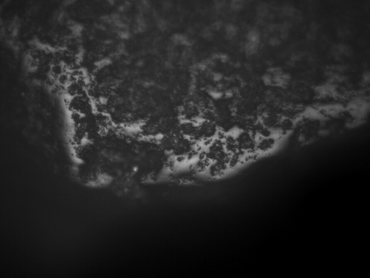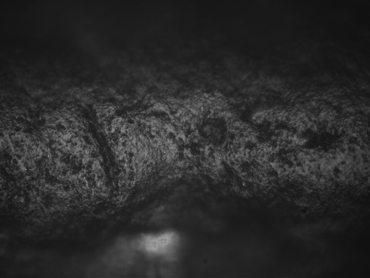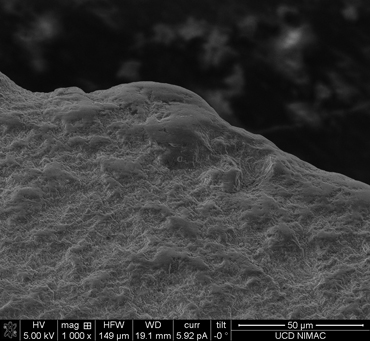The use of flint in the Irish Neolithic
PhD Candidate: Sol Mallía-Guest
Supervisors: Dr Graeme Warren
Funded By:
Abstract
This project aims to understand the roles of knapped flint artefacts throughout the Neolithic (3800 – 2600 cal BC) by assessing the decisions involved in their manufacture, use and final deposition through a technological and microscopic functional analysis on a selection of assemblages from formal structures (e.g. rectangular timber houses) and other non-structural contexts (e.g. pits, spreads) in eastern and southern Ireland.
The research in context
Settlement and subsistence debates in the Irish Neolithic have revolved around a continuum of “domestic” evidence epitomized by the well-defined occurrence of the early rectangular houses and their association with early farming practices to the presence of isolated pits, scattered less formal features or the exiguous number of circular structures dated through the period.
Changes in architectural design have been considered to suggest a shift in the social role of these structures but also in the range of activities associated with them (Grogan 2004,112; Cooney 2000, 78-81). Quotidian activities and stone as a pivotal resource are regarded as playing a critical role in defining these groups’ identities (Smyth 2007; Cooney 2007, 258). However, as the characterization of Irish Neolithic knapped assemblages (Woodman 1994, Nelis 2004) has been on traditional typological basis focusing on finished forms or in terms of technological variability exclusively, little is understood about their use for particular tasks: a key dimension of their life-histories.
While functional lithic studies in Ireland are not a novelty, they have been erratic and limited, and so the choices deployed in the modes of use of these formal and informal tools are yet to be systematically explored to understand their roles in specific contexts and activities structuring the changing social dynamics of the period.
The approach here proposed aims to assess both synchronically and diachronically four broad aspects that will aid to reassemble these artefacts’ biographies comprehensively:
- How and on which range of materials were flint artefacts used?
- What is the nature of the activities and the context of use they were involved in?
- How does the use dimension articulate with technological choices and depositional contexts?
- Which particular artefact/activity associations and depositional practices can be elicited throughout the period?
The case studies will include a selection of the available Neolithic settlement evidence with firmly radiocarbon dated contexts or undisturbed, yet relative, contextual associations primarily from Leinster and south Munster. These will comprise rectangular and circular structures as well as other features, such as pits and spreads with a particular emphasis placed along the southeastern corridor and the recently uncovered evidence in counties Kildare-Carlow and Kilkenny-Waterford
Methodology
The entirety of the selected flint assemblages will be subject to a holistic approach based on the chaîne opératoire combining a macroscopic techno-morphological analysis and a microscopic use-wear study carried out under different optical conditions (e.g. “high-power approach” principles and stereomicroscope observations). The functional variables and their qualitative attributes will be recorded on individual basis, including the presence of possible residues, to inform on the modes of working and the nature of the materials worked. This methodology also requires the expansion of the current experimental reference collection as heuristic comparative device to assist in the interpretation of use-wear traces and understanding of the processes involved in their formation. For this purpose, a number of experimental case studies including the replication of different tasks (e.g. hide-scraping, wood-working, cereal reaping, bone/pottery/stone/shell perforating, etc.) and hafting methods will be carried out following an ethnographically documented and well-established corpus of previous research on the topic. Given the subjective character of the analysis a pilot case on use-wear quantification based on SEM (Scanning Electron Microscope) images and/or laser profilometry (UBM) will shed light on more ambiguous assessments.

Experimental traces from cutting barley (EXP6, 200x) (Mallía-Guest 2011)

Experimental dry hide-working traces (EXP12, 200x) (Mallía-Guest 2011)

SEM micrograph detailing the topography of the experimental flint piece used for reaping barley (EXP 6, 1000x; UCD NIMAC)
References
Cooney, G. 2000. Landscapes of Neolithic Ireland. Routledge, London.
Cooney, G. 2007. Parallel Worlds or Multi-stranded Identities? Considering the Process of ‘Going Over’ in Ireland and the Irish Sea Zone. Proceedings of the British Academy 144,543 – 566.
Grogan, E. 2004. The Implications of Irish Neolithic Houses. In Shepherd, I. and G.Barclay (eds) Scotland in Ancient Europe: The Neolithic and Early Bronze Age of Scotland in their European Context, 103 – 114. Society of Antiquaries of Scotland, Edinburgh.
Nelis, E. 2004. Neolithic Flint-Work from the North of Ireland: Some Thoughts on Prominent Tool Types and their Production. In Gibson, A. and Sheridan, A. (eds). From Sickles to Circles: Britain and Ireland at the Time of Stonehenge, 155 – 175. Tempus, Gloucestershire.
Smyth, J. 2007. Neolithic Settlement in Ireland: New Theories and Approaches. Unpublished PhD Thesis. School of Archaeology. University College Dublin.
Woodman, P. 1994. Towards a Definition of Irish Early Neolithic Lithic Assemblages. In Ashton, N and David, A. (eds) Stories in Stone. Lithic Studies Society Occasional Papers 4, 212 – 218. Lithic Studies Society, Cambridge.